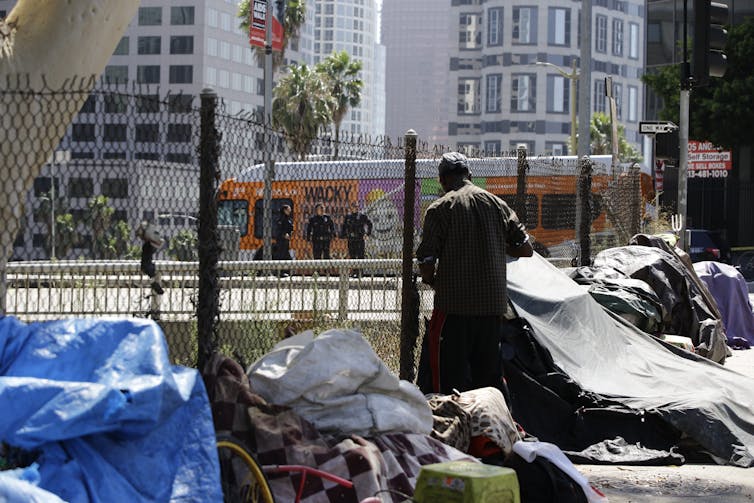Los Angeles is far from ending homelessness – but other American cities can still learn a lot from it
- Written by Brenda Wiewel, Director of the Initiative to Eliminate Homelessness, University of Southern California
Los Angeles became ground zero for America’s homelessness crisis after President Donald Trump visited the city[1] on Sept. 17.
“We can’t let Los Angeles, San Francisco and numerous other cities destroy themselves by allowing what’s happening,” Trump said[2]. They’re ruining the “best highways, our best streets, our best entrances to buildings.”
While the Trump administration’s prioritization of highways and buildings over people is far from heartwarming, he does have a point in highlighting LA and its homeless problem – but not for the reasons he thinks.
As an expert in homelessness[3], I’ve studied the many ways Los Angeles has tried to deal with homelessness on its streets. While some plans have worked better than others, I believe the city’s efforts are instructive for policymakers across the country who want to tackle their own homeless problems.
 Secretary of Housing Ben Carson tours the Union Rescue Mission in Skid Row during Trump’s time in LA.
AP Photo/Damian Dovarganes[4]
Secretary of Housing Ben Carson tours the Union Rescue Mission in Skid Row during Trump’s time in LA.
AP Photo/Damian Dovarganes[4]
Homelessness in LA
The United States’ homeless population is concentrated on the West Coast and in the Northeast, with almost half in California[5] alone.
Coastal cities are especially prone to homelessness because there’s not enough affordable housing[6] and real estate prices tend to be very high[7].
Rents are increasing[8] in LA[9] as well. When more than half of a household’s monthly income goes to pay rent, there is not enough left for living expenses[10].
As a result, homeless encampments have cropped up in every part of the city. An increasing number of unsheltered homeless people[11] in the U.S. — those who are on the streets as opposed to in temporary shelters — live in LA.
Rampant homelessness not only hurts those living on the streets – as seen by rising death rates[12] – but also harms all residents of a community[13], including economically[14].
What hasn’t worked
Many of LA’s efforts to tackle the problem have actually followed Trump’s approach: Treat it as a nuisance and keep it out of sight and away from where people live and work.
In the early 2000s, LA officials tried an approach known as the Safer Cities Initiative[15] with a focus on Skid Row, an area of downtown LA that contains the largest homeless population in the U.S.[16] It was supposed to clean up crime and community disorder by promptly targeting minor crimes[17], such as jaywalking or littering.
Later reports showed that it did not reduce extreme[18] poverty or crime[19]. It succeeded only in criminalizing homelessness and emphasizing problems of racial inequality[20].
In 2017 the city banned people from sleeping in their cars[21] in residential areas and near schools and parks. And the city council has been debating limits on where people can sleep in the streets, without being able to come to any agreement[22].
The city has also tried to clear out encampments, which has resulted in homeless advocates filing lawsuits[23] over the constitutionality of removing people’s belongings[24].
 LAPD officers guard a ramp by a displaced homeless camp during Trump’s visit to LA.
AP Photo/Damian Dovarganes[25]
LAPD officers guard a ramp by a displaced homeless camp during Trump’s visit to LA.
AP Photo/Damian Dovarganes[25]
Exploring other options
Some of the city’s approaches, however, have focused more on addressing the root causes of homelessness and have the backing of research[26].
One such initiative[27] known as the Coordinated Entry System has brought together the government, nonprofit groups and private citizens to create a database of homeless people that documents their progress in and out of services.
The initiative also helped match people with available housing resources. It is structured to prioritize the most vulnerable homeless people, such as those with multiple health conditions that may be fatal within a year without intervention.
From 2017 through 2018, homelessness decreased significantly[28] in many areas that used this system.
Additionally, there has been an effort to inform policy decisions through data analysis[29] by partnering with universities[30] and to address conditions on the streets by working with encampments to provide shelter tied to permanent housing[31]. Through a recent sales tax increase, Los Angeles area communities now have access[32] to expanded outreach, housing and other resources.
As a result, there is capacity to reach more people experiencing homelessness. New regulations provide incentives to encourage developers to build more affordable housing units[33], and the city plans to put multiple housing units on the market[34] over the next few years. Units will include homes and apartments.
The city has also made a commitment to addressing the role of race and structural inequality[35], bringing together the community, scholars and government representatives to investigate why African Americans[36] make up 40% of all homeless people[37] but only 9% of the total population in LA.
Although homelessness remains a serious problem in Los Angeles, the city is starting to take steps to address it based on best practices rather than simply removing the problem from sight.
[ Deep knowledge, daily. Sign up for The Conversation’s newsletter[38]. ]
References
- ^ visited the city (www.latimes.com)
- ^ Trump said (www.businessinsider.com)
- ^ expert in homelessness (homelessness.usc.edu)
- ^ AP Photo/Damian Dovarganes (www.apimages.com)
- ^ almost half in California (www.whitehouse.gov)
- ^ there’s not enough affordable housing (la.curbed.com)
- ^ real estate prices tend to be very high (www.pewtrusts.org)
- ^ Rents are increasing (usc.data.socrata.com)
- ^ in LA (www.youtube.com)
- ^ not enough left for living expenses (www.pewtrusts.org)
- ^ An increasing number of unsheltered homeless people (endhomelessness.org)
- ^ rising death rates (www.latimes.com)
- ^ all residents of a community (classroom.synonym.com)
- ^ economically (www.americansecurityproject.org)
- ^ Safer Cities Initiative (crimesolutions.gov)
- ^ largest homeless population in the U.S. (www.lachamber.com)
- ^ targeting minor crimes (qz.com)
- ^ did not reduce extreme (www.npr.org)
- ^ crime (www.newyorker.com)
- ^ emphasizing problems of racial inequality (doi.org)
- ^ banned people from sleeping in their cars (www.lamag.com)
- ^ without being able to come to any agreement (www.dailynews.com)
- ^ has resulted in homeless advocates filing lawsuits (la.curbed.com)
- ^ removing people’s belongings (la.curbed.com)
- ^ AP Photo/Damian Dovarganes (www.apimages.com)
- ^ backing of research (www.hiltonreport.abtscrolls.com)
- ^ One such initiative (ceslosangeles.weebly.com)
- ^ decreased significantly (www.kcet.org)
- ^ through data analysis (www.arcgis.com)
- ^ partnering with universities (www.dailynews.com)
- ^ provide shelter tied to permanent housing (empowerla.org)
- ^ Los Angeles area communities now have access (data.lacounty.gov)
- ^ build more affordable housing units (inclusionaryhousing.org)
- ^ multiple housing units on the market (la.curbed.com)
- ^ race and structural inequality (www.centerforsocialinclusion.org)
- ^ investigate why African Americans (www.lahsa.org)
- ^ 40% of all homeless people (www.lahsa.org)
- ^ Sign up for The Conversation’s newsletter (theconversation.com)
Authors: Brenda Wiewel, Director of the Initiative to Eliminate Homelessness, University of Southern California

